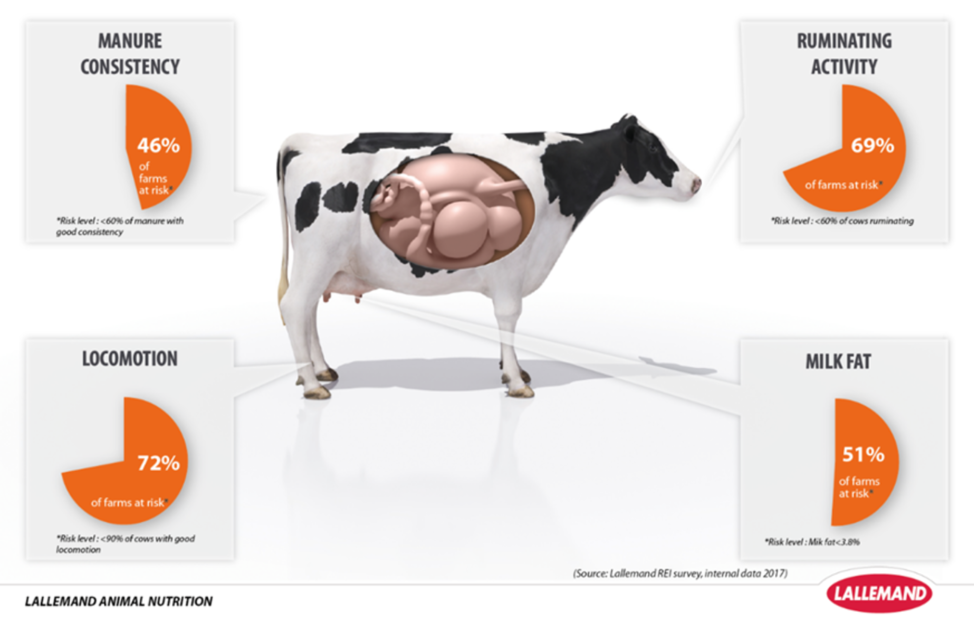By Bryan Buckley, Lallemand Animal Nutrition
With most cows out full-time now and breeding in full swing, there will be a huge uptake of nitrogen by grass and covers will get lush and heavy.
This lush grass diet can cause rumen pH to drop below optimal levels, a condition known as sub-acute ruminal acidosis (SARA). The rumen, with its billions of microorganisms, is a formidable fermenter transforming feed into energy, nutrients and finally milk.
Poor rumen efficiency, causing SARA, can be a significant source of economic loss for the producer. Research studies (Figure 1) have reported SARA prevalence at around 20-30% in herds.
Irish cows appear far from immune, with one Irish study reporting 53% of dairy cows showing signs of SARA.
Signs of SARA – 4 key rumen efficiency indicators
- Manure consistency assessment reflects digestive function. Liquid manure indicates poor rumen efficiency due to an increased passage rate, possibly from an imbalanced diet and SARA. The presence of undigested processed grains in manure shows sub-optimal rumen efficiency.
- Rumination activity is linked to rumen function and health. It has been shown that a lack of ruminating activity may be due to reduced rumen motility during acidosis (Allen 1997; Grant et al., 1990).
- Locomotion – Lame animals can have high levels of histamine production and bacteria endotoxin release in the rumen, which is often linked to SARA (Nocek, 1997).
- Milk fat – Milk component yield is a consequence of rumen efficiency and milk fat is directly linked to rumen pH (SARA) and overall rumen function.

Figure 2: Survey of dairy farms in relation to four key rumen efficiency indicators (Lallemand internal data, 2017)
Levucell SC – fighting the signs of SARA
- Manure consistency – On-farm audits in Finland showed that using live yeast Levucell SC increased the percentage of manure with optimal consistency from 57% to 70%.
- Rumination activity – A Bologna University trial showed that the percentage of cows ruminating for more than 400min/day was increased from 52% to 65% when supplemented with Levucell SC (Fustini et al., 2013).
- Locomotion – A study from the University of Sydney indicated that the level of rumen histamine was significantly decreased by 69% with Levucell SC as compared to the control (Golder, 2014). On-farm audits in Denmark showed the percentage of cows with good locomotion score increased from 58% to 84% with Levucell SC.
- Milk fat – A University of Guelph trial showed the positive effect of Levucell SC on milk fat percentage, increasing from 3.55% to 3.71% (De Vries, 2014).
Levucell SC – How does it work?
Rumen specific live yeast strain LEVUCELL SC (Saccharomyces cerevisiae CNCM I-1077) has been selected from over 1,000 yeast strains for its activity in the rumen and benefits today from a robust scientific documentation regarding its effects and modes of action (Figure 3).

Figure 3: Overview of LEVUCELL SC documented effects in the rumen (over 100 scientific communications on this yeast strain)
Surviving the pelleting process with TITAN technology
All LEVUCELL SC supplied to Irish feed mills comes with a patented micro-encapsulation technology called TITAN.
Thanks to TITAN’s unique fat coating, live yeast strain Saccharomyces cerevisiae CNCM I-1077 is better protected from humidity and steam during the meal conditioning and pelleting process.
TITAN is the most adapted technology available to protect yeast viability. Is the yeast in your dairy nut TITAN protected?
More information
For further information and scientific resources about the rumen and potential challenges that can be found on farm, just click here
To find out about the availability of LEVUCELL SC for inclusion in your feed or mineral please contact Lallemand Animal Nutrition’s Bryan Buckley at: 086-8482466 or email: [email protected]



